Brush-clawed shore crab
Introduction
The brush-clawed shore crab is a small crab (up to 2.5cm) that is usually orange-brown in colour, but can be green or maroon. It can be distinguished by the light brown to yellow fur patches at the base of the pincers on the male’s claws.
It lives in a range of habitats from rocky intertidal to muddy subtidal habitats and is an omnivorous species with a broad diet that can compete with native crabs and prey upon native fish and invertebrate species.
Identification
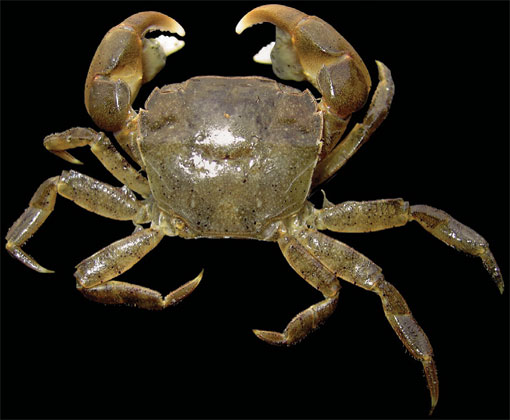
Brush-clawed shore crab / Hemigrapsus takanoi
Key features:
- Light brown to yellow fur patches at base of pincers on male’s claws
- Small dark spots on claws
- 3 spines on either side of eyes
- Light and dark banded legs
- Most commonly orangey-brown in colour, can be green or maroon
Known locations:
- Not recorded in Australia
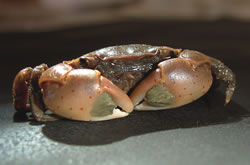
Habitat:
- Rocky intertidal habitats, but is also found in soft sediments
Impacts:
- Broad diet, competes with and preys upon native species
Similar native species
These native species may be confused with this marine pest.
Swift-footed crab / Leptograpsus variegatus
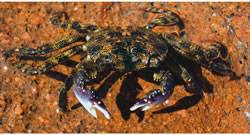
Key features:
- Dark-olive green to dark purple
Shell up to 8cm wide - Purple claws with white tips
- Three spines on either side of eyes
Habitat:
- Exposed rocky shores, intertidal
Smooth shore crab / Cyclograpsus audouinii
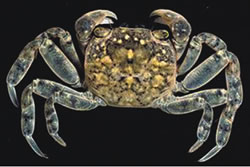
Key features:
- No spines either side of the eyes
- Smooth rounded shell up to 4cm wide
- Varied colours from red-brown/purple and yellow to purple, dark grey or brownish grey
Habitat:
- Under rocks on sheltered and moderately exposed shores
Sowrie / Plagusia glabra
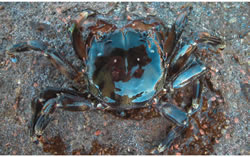
Key features:
- Smooth shell green-brown colour
- 4 distinct spines on either side of eyes, spines on legs
Habitat:
- Intertidal, exposed rock platforms or rock pools
Spotted smooth shore crab / Paragrapsus laevis
Key features:
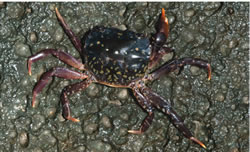
- Shell width up to 4cm
- 2 spines either side of eyes
- First set of legs felted with hairs
Habitat:
- Intertidal, sheltered coastal bays and estuaries, prefers hiding under rocks, debris and in mangroves
What is NSW DPIRD doing?
On the 1st July the NSW Government implemented a new Biosecurity Act 2015 (the Act). Under Schedule 2 of this Act the Brush Clawed Shore Crab is declared as prohibited matter in NSW. This means it is illegal to possess, buy, sell or move this pest in NSW. Heavy penalties apply for non-compliance. In addition, NSW DPIRD has the power to seize and require the destruction of the pest.
People are expected to have a basic level of knowledge about the biosecurity risks they might encounter in their normal work and recreational activities. All community members have a general biosecurity duty to consider how actions, or in some cases lack of action could have a negative impact on another person, business enterprise, animal or the environment. We must then take all reasonable and practical measures to prevent or minimise the potential impact.
How can you help?
Learn to recognise, and be aware of, the brush-clawed shore crab so that you can report any suspected new sighting.
If you see this pest in NSW, please report it immediately
- Note the exact location
- If possible take a photo and/or collect a sample
- Freeze sample in a plastic bag
- Report your sighting